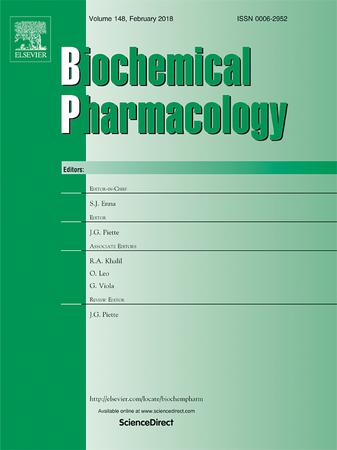线粒体蛋白酶ClpP是多发性骨髓瘤治疗的一个有希望的靶点。
IF 5.3
2区 医学
Q1 PHARMACOLOGY & PHARMACY
引用次数: 0
摘要
耐药和复发是多发性骨髓瘤(MM)治疗的主要障碍,促使人们寻找新的治疗方法。线粒体酪蛋白溶解蛋白酶P (ClpP)的化学激活已被证明对许多肿瘤具有抗癌作用,但在MM中很少被阐明。我们发现ClpP在MM患者中表达升高,在复发病例中进一步升高。在合成和筛选一组ClpP激动剂后,我们确定了一种化合物7b是体外最有效的抗mm剂。7b激活ClpP蛋白酶活性,选择性地降解线粒体蛋白,其中许多参与氧化磷酸化(OXPHOS)。结果,7b处理的MM代谢功能障碍,线粒体膜电位(MMP)崩溃,OXPHOS水平降低,线粒体活性氧(ROS)增加,导致线粒体自噬介导的MM细胞死亡。值得注意的是,7b对耐药MM细胞系也有疗效,包括硼替佐米和来那度胺耐药细胞。在体内,7b也表现出显著的抗mm活性,副作用可耐受。总之,靶向ClpP是一种很有前景的MM治疗策略,7b作为一种有效的抗MM药物,特别是对于复发和难治性MM。本文章由计算机程序翻译,如有差异,请以英文原文为准。

The mitochondrial protease ClpP is a promising target for multiple myeloma treatment
Drug resistance and relapse are the major obstacles in multiple myeloma (MM) treatment, driving the search for novel therapeutics. The chemoactivation of mitochondrial caseinolytic protease P (ClpP) has shown to have anticancer effects on many tumors, but has seldom been elucidated in MM.
Here we found that the CLPP expression was elevated in MM patients, and further increased in relapsed cases. After synthesizing and screening a panel of ClpP agonists, we identified a compound, 7b, as the most potent anti-MM agent in vitro. 7b activated ClpP protease activity, selectively degrading mitochondrial proteins, many of which are involved in oxidative phosphorylation (OXPHOS). As result, 7b treated MM had metabolic dysfunction, the mitochondrial membrane potential (MMP) collapse, reduced OXPHOS levels, and increased mitochondrial reactive oxygen species (ROS), leading to mitophagy-mediated MM cell death. Notably, 7b also showed efficacy against drug-resistant MM cell lines, including bortezomib- and lenalidomide-resistant cells. In vivo, 7b also exhibited remarkable anti-MM activity with tolerable side effects.
In conclusion, targeting ClpP represents a promising therapeutic strategy for MM, with 7b serving as a potent anti-MM agent, especially for relapsed and refractory MM.
求助全文
通过发布文献求助,成功后即可免费获取论文全文。
去求助
来源期刊

Biochemical pharmacology
医学-药学
CiteScore
10.30
自引率
1.70%
发文量
420
审稿时长
17 days
期刊介绍:
Biochemical Pharmacology publishes original research findings, Commentaries and review articles related to the elucidation of cellular and tissue function(s) at the biochemical and molecular levels, the modification of cellular phenotype(s) by genetic, transcriptional/translational or drug/compound-induced modifications, as well as the pharmacodynamics and pharmacokinetics of xenobiotics and drugs, the latter including both small molecules and biologics.
The journal''s target audience includes scientists engaged in the identification and study of the mechanisms of action of xenobiotics, biologics and drugs and in the drug discovery and development process.
All areas of cellular biology and cellular, tissue/organ and whole animal pharmacology fall within the scope of the journal. Drug classes covered include anti-infectives, anti-inflammatory agents, chemotherapeutics, cardiovascular, endocrinological, immunological, metabolic, neurological and psychiatric drugs, as well as research on drug metabolism and kinetics. While medicinal chemistry is a topic of complimentary interest, manuscripts in this area must contain sufficient biological data to characterize pharmacologically the compounds reported. Submissions describing work focused predominately on chemical synthesis and molecular modeling will not be considered for review.
While particular emphasis is placed on reporting the results of molecular and biochemical studies, research involving the use of tissue and animal models of human pathophysiology and toxicology is of interest to the extent that it helps define drug mechanisms of action, safety and efficacy.
 求助内容:
求助内容: 应助结果提醒方式:
应助结果提醒方式:


